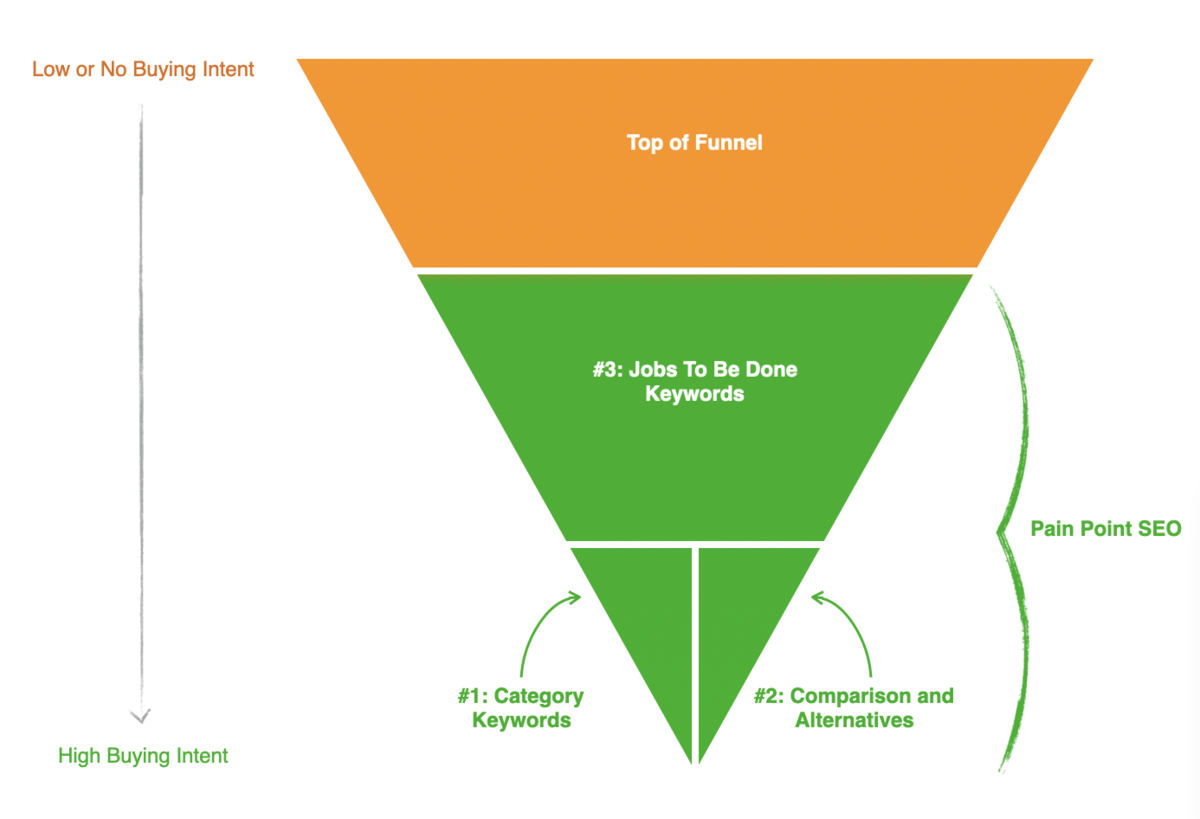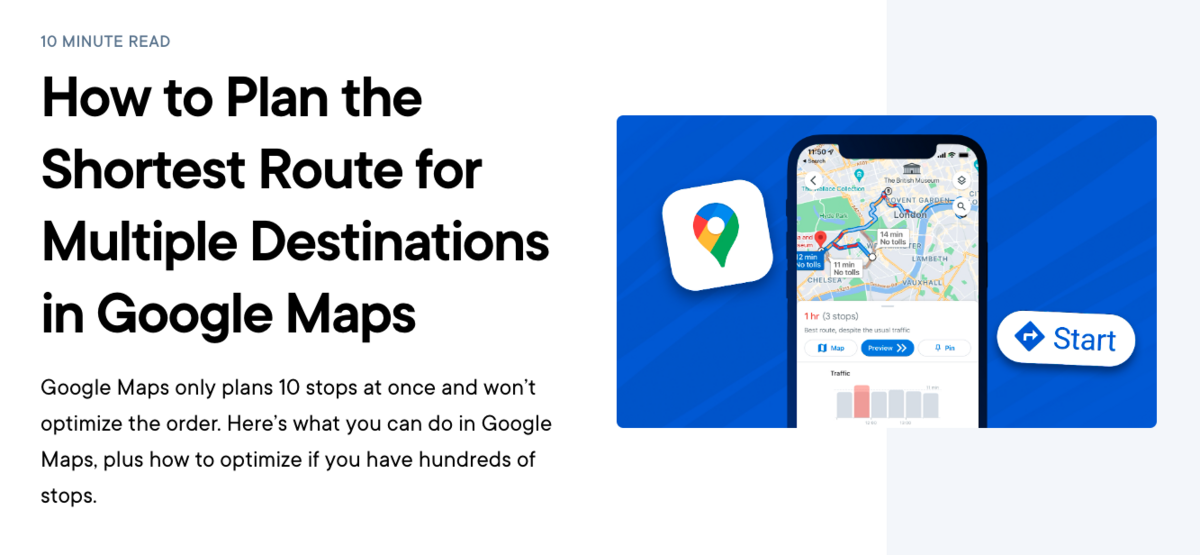Our Pain Point SEO approach prioritizes keywords that are high intent over ones that are high search volume with lower buying intent. Our goal is to drive conversions, not solely traffic. This means we want to rank our clients in Google for search terms that indicate the person is ready to buy. Once we’ve covered all those bottom-of-funnel (BoF) keywords, we move up-funnel to target search terms with lower/mixed intent.
In our experience, there are three main types of high-converting keywords:
- Category keywords, where someone’s looking for your product or product category; they’re ready to buy what you offer, and just need to be convinced that you have the solution they need. This includes searches such as ‘best crm software’ and ‘children’s hiking boots’. Plus all the variations, for example ‘best crm system’ and ‘children’s hiking shoes’.
- Comparisons and alternatives, where someone’s comparing products or services in your space. In the case of a project management software, this might be ‘trello vs asana or alternatives to zoho’. Again, the searcher is indicating their readiness to buy.
- Jobs-to-be-done, where someone is indicating that they want to achieve a goal or complete a task. For example, ‘how to do financial projections’, ‘best way to clean grout’, or ‘natural way to increase testosterone’.
Note: To learn more about JTBD keywords, read my previous post: How to Use Jobs-to-Be-Done (JTBD) Keywords in Your SEO Content Strategy

There are loads of opportunities within all of these categories, so you won’t be short of topics to write about—whatever industry you’re in. And as well as the clear and obvious opportunities (e.g. ‘best crm software’), there’s a not-so-obvious approach you can try, too.
We call these more obscure opportunities ‘deviant’ keywords.
Deviant keywords aren’t immediately evident, and you might even consider them ‘wrong’—but they make sense to target because they’re still likely to generate conversions for your business.
In this post, I’ll explain what deviant keywords are and show some examples of how they work.
What are deviant keywords?
Deviant keywords are keywords that seem unusual, and on first glance they’d appear to be unacceptable for you to use in your content marketing strategy. Generally, finding deviant keywords demands a certain amount of ‘outside-the-box’ thinking.

Granted, a deviant keyword does sound pretty menacing. But we can thank the Cambridge Dictionary for the neat definition that we’ve been able to use for this concept:

What are the different types of deviant keywords?
First, it’s worth outlining what I’m not talking about when I suggest targeting deviant keywords:
I’m not suggesting you write content to rank for random keywords simply to generate traffic. This can be tempting, especially if you can see your competitors’ websites getting a lot of visitors. But website traffic by itself is a vanity metric. It’s better to have modest traffic but a high percentage of visitors converting—e.g. signing up to a free trial, sending an inquiry, or calling your office—and that’s why we even target mini-volume keywords for our clients.
Deviant keywords are simply a non-intuitive or seemingly wrong way to achieve that same end: get conversions from SEO and content.
Let’s look at examples of deviant keywords in each of our three Pain Point SEO frameworks.
First, Deviant keywords can be found in category keywords (from our Pain Point SEO framework):
- Inaccurate descriptions of a product or service: People use all sorts of phrases to describe what they need, many of which aren’t technically correct. In some cases, Google will default its SERPs to the correct search, but not always. It pays to ‘meet searchers where they are’ rather than sticking to the terminology that you deem to be accurate.
For example, some companies we’ve worked with have had major BoF category keywords (with high search volume = great opportunities) that are downright wrong. I’ll dig into two of these stories later in this post. - Overestimation of needs: Sometimes people assume they need a big expensive tool when they actually need something very specific. For example, the Timetastic app is designed specifically for companies to manage staff leave. It won’t help with other HR tasks (hiring, resource planning, payroll, etc.) but for many businesses, that functionality would be overkill anyway. Many people searching ‘hr software for leave management’ don’t actually need HR software, per se—they just need something that helps them schedule and record staff leave. Thus, this would be a good deviant keyword because not everyone understands the jargon and nuances between types of software.
- Underestimation of needs: Our client, StrataPT, offers a complete platform for physical therapy (PT) practices, but their main functionality is billing (because reimbursement from insurance companies is a nightmare). In this case, calling their product ‘billing software’ is technically inaccurate, because it does so much more. But people searching for this keyword are still great prospects, because one of—if not the main—benefit of buying their software is to improve their billing process and collection rate. Plus, in fact, standalone billing software without the other stuff never gets the same results anyway.
- Free/Freemium: If your product isn’t free, it may feel weird to target this keyword—but there are logical angles here. If it’s a SaaS product and you offer a free subscription plan, it isn’t really a deviant keyword. And if you only offer a temporary free trial, we don’t recommend framing your product as free because that just annoys people. In this case, we’d target the ‘free’ keyword by writing a piece that highlights the pros/cons of free software (mainly the cons). For example, The Hidden Costs of Free CRM Software.
And in the comparisons and alternatives keyword group, such as:
- Non-ideal alternatives: Several marketing experts will say not to sell too hard to people who aren’t yet ‘product-aware’ because they’re not ready to buy. We think differently because, in our experience, someone who demonstrates a pain point is open to a good product or service that will solve their problem. Even when they’ve searched for something else, as long as that ‘something else’ is indicative of their pain point, you have a real chance of convincing them your solution is worth a shot instead.
An example to illustrate the point: Let’s say you have a software that helps companies with staff travel (from a quick Google search, one prominent brand is TravelPerk). The keyword ‘travel request form’ is an example of a non-ideal alternative; the searcher is indicating they need something to help them to organize corporate travel (they might be an employee themselves or HR trying to formalize the process for staff). If using TravelPerk is better than processing forms manually, this is a great place to make that argument.
In fact, TravelPerk has targeted this keyword with What is a business travel request form?. But in my view, they’d be better off taking a different angle: either leading explicitly with the downsides of using a travel request form, or targeting travel request form template instead—providing a template, while making the case for their alternative.
Again, this keyword is ‘wrong’ because TravelPerk is the antithesis of a template for manually managing corporate travel. It doesn’t actually describe their solution at all.
Another non-ideal alternative could be a non-ideal competitor; an example would be a tool that has a proportion of users/potential users whose needs overlap with what TravelPerk offers. This might be a software focused only on travel expenses and financial records. In that case, they might want to target a keyword like ‘payhawk alternatives’.
We did something similar for Leadfeeder, a software that helps B2B companies see what businesses are visiting their website. At that time, it was built on top of Google Analytics, and wasn’t a replacement for it at all (it doesn’t touch any traffic analytics or other core features of Google Analytics). But we targeted the term ‘google analytics alternatives’, which converted very well for them. As of now, that post (note: heavily edited since we first published it) still ranks in the top 5 spots for that keyword.
And finally, in the jobs-to-be-done (JTBD) group of keywords:
- Inefficient ways of doing a job: This is pretty similar to the non-ideal alternatives (see above)—but with more emphasis on the task that needs to be completed.
For example, an accounting software might want to target ‘how to create an invoice in word’ because the person searching for this is doing something arduous when they can offer a better alternative (perhaps without cost, if the feature is part of the free plan). At first this seems irrelevant because your product would have absolutely nothing to do with Microsoft Word, but actually, the searcher is telling you they want to do something in a way that you know is costing them time and energy, with substandard results.
(In my post about JTBD keywords, I also mention the article we wrote for Circuit’s route planner about how to create a route for multiple destinations using Google Maps. We gave the step-by-step process for doing this while highlighting the hassle it involves, and the fact there’s a maximum limit of 10 stops. This post has generated thousands of free trial signups for Circuit because we put forward a convincing case that using Circuit is better than fiddling with Google Maps to find workarounds. More on this later.).
Again, what we’re not talking about here is targeting irrelevant keywords for the sake of getting web traffic. Deviant keywords will still generate conversions.
When does targeting deviant keywords make sense?
Targeting deviant keywords usually makes sense when you’ve already covered all of your high-priority bottom-of-funnel keywords.
We tend to prioritize in the below order (though not always):
- Category keywords
- Comparisons and alternatives
- Jobs-to-be-done keywords
- The deviant keywords within each of the groups above
In most cases, deviant keywords can be considered ‘mid-funnel’ opportunities. In other words, they’re either demonstrating an inherently lower buying intent, or we think that the buying intent of the people searching for it is more mixed and uncertain (i.e. some want to buy, others don’t).
There are exceptions to this, however. These exceptions are mainly deviants within the category keywords. As I noted earlier in this post, inaccurate descriptions can sometimes be very high intent; the issue is simply that the searcher doesn’t have their terminology correct. In the next section of this article, I’ll give you an example of a company whose highest-intent keyword was a deviant keyword because it was a popular misconception about their technology.
But mostly, these deviant keywords are something to look at when you start to move up the funnel, after exhausting all of the keywords that are likely to give you the most conversions.
3 real-world examples of targeting deviant keywords
I’m going to wrap up this article with three examples of how we’ve embraced deviant keywords and achieved results for real-world clients.
1. Renewable heating company: Using an inaccurate category description
A few years ago, I worked with a UK-based renewable energy company that specialized in sustainable heating and cooling. Charged with growing their organic traffic and online inquiries, I started exploring BoF category keywords; the ways people described their products.
There were some pretty obvious ones that they were already targeting on Google Ads, including:
- air source heat pump
- ground source heat pump
- heat pump for cooling
- heat pump system for house
As well as some middle-of-funnel keywords, such as:
- how much does a heat pump cost
- heat pump settings for winter
- heat pump vs furnace
- how does a heat pump work
These were all good opportunities. But speaking to the sales and customer service teams uncovered something interesting: as experts in the technology, they were really frustrated that people kept coming to them asking about geothermal heat pumps.

In the UK, a geothermal heat pump means something very specific; it’s not at all suitable for residential properties (although the US seems to have adopted this term more easily). Geothermal heating is generally an industrial solution, involving drilling a massive borehole deep into the earth close to the earth’s core. Not something you’d want to do in your back garden.
This mistake annoyed the team, because they cared a lot about the technology. Yet this was the language people were using to describe what they needed.
I managed to convince them that despite the description ‘geothermal heat pump’ being erroneous, keywords like the following were worth writing content about:
- residential geothermal heat pump
- geothermal heat pump installation cost
- water to water geothermal heat pump
- best geothermal heat pump
The beauty is that many of their competitors were similarly frustrated by the popular misconception about geothermal energy and were avoiding the keywords, too. This meant they were actually much less competitive in the SERPs than the correct descriptions at the time.
The lesson here is to not be too precious about your product or service. If people are using certain language to describe their needs, it makes sense to be there for those searches. You can then use your posts and pages to explain the nuances of what they really need (if that matters).
As this was a few years ago, I unfortunately don’t have the conversion metrics for these specific geothermal keywords. But I do know that they contributed to an overall 8x growth in conversions and a growth of 3,400% in (high-intent) organic traffic over two years.
2. Cognitive FX: Embracing unwanted terminology
My colleagues, Olivia Seitz and Devesh Khanal, put together a full case study about our work with Cognitive FX: How We Grew Cognitive FX to 70,000 Pageviews in 14 Months.
Cognitive FX is a concussion treatment center based in Provo, Utah. What we haven’t highlighted in our case study is that one of their best-performing keywords—one that we’ve used across dozens of posts—is actually one their medical professionals didn’t want to use.
The doctors at Cognitive FX are not fans of the term ‘post-concussion syndrome’ because ‘persistent post-concussion symptoms’ is the most up-to-date, medically accurate description. But patients—and many in the medical community who don’t specialize in the condition—will search for post-concussion syndrome or its abbreviation, PCS.
Keywords such as ‘post concussion syndrome test’, ‘living with post concussion syndrome’, ‘what can a neurologist do for post concussion syndrome’, or ‘how to treat pcs’ are high-intent, and therefore, valuable — despite searchers using the ‘wrong’ term to describe their problem.

The articles that are targeting PCS-related terms accounted for 23% of all blog conversions in the month prior to us writing this post. According to Olivia, these articles are consistently driving 20-25% of all blog conversions on a monthly basis.
Plus, there are other opportunities around wrong—or at least strange—ways to describe the condition. For example, an article targeting ‘neuroplasticity treatment’ has consistently brought in conversions. It’s not a term their clinicians would ever use, but it’s one of the ways their target patients search for help online.
We can learn from these two companies that if you have a complex service or product—whether it’s technical, medical, financial, or something else—many people searching for it (and around it) will use terms that are wrong, ambiguous, or non-ideal. Don’t avoid these keywords. Instead, invest some time and effort in uncovering these deviant keywords.
3. Circuit: Combining JTBD with an alternative/competitor
A deviant approach to jobs-to-be-done keywords (e.g. ‘how to’ and ‘can I’ keywords) is to combine them with alternatives that might seem irrelevant at first glance. In this case, the person is asking ‘how can I do [task] using [tool]?’—in many cases, they’re deviant keywords because these alternative tools do not directly relate to your product or service, and the search suggests that the person is already dead-set on what solution they’re going to rely on (and it’s not yours).
However, we don’t write these keywords off because the person is trying to complete a task in a way that we know is inefficient, full of hassle, and prone to error. This gives us a chance to convince that searcher that they’re better off taking a different route now or in the future.
One of the strongest examples of this approach is our article for Circuit, a software for delivery companies that handles route planning, courier tracking, and much more.
We decided to target the keyword, ‘how to plan the shortest route for multiple destinations in google maps’ even though this was helping someone do something without using Circuit. The idea was that by taking the searcher through the step-by-step process of planning an efficient route for multiple stops in Google Maps, they’ll see that it’s actually a real pain.

This pain then opens up an opportunity for us to make the case for Circuit being a better option.
The bonus is that a significant number of people searching for this are doing so because they’re making deliveries. They don’t say that in their search term, but that’s one of the primary reasons for someone needing to create the shortest route from a list of destinations. This is Circuit’s main audience, and as a result, this post has generated thousands of free trial signups.
Learn More About Our SEO and Content Marketing Agency
- Our Agency: If you want to hire us to execute a content-focused SEO strategy built around generating leads, not just traffic, you can learn more about working with us here.
- Join Our Content Marketing Team: If you’re a content marketer or writer and would love to do content marketing in this way, we’d love to have you apply to join our team.
- Our Content Marketing Course: Individuals looking to learn our agency’s content strategy and become better marketers, consultants, or business owners can join our private course and community, taught via case studies, and presented in both written and video content formats. We include several details and examples not found on this blog. Our course is also built into a community, so people ask questions, start discussions, and share their work in the lesson pages themselves, and we, along with other members, give feedback. Learn more here.








